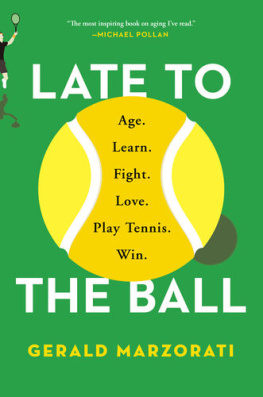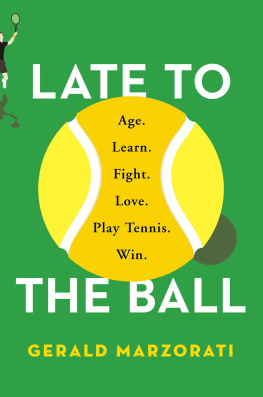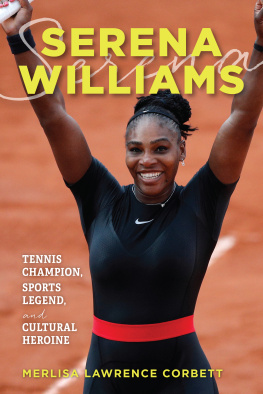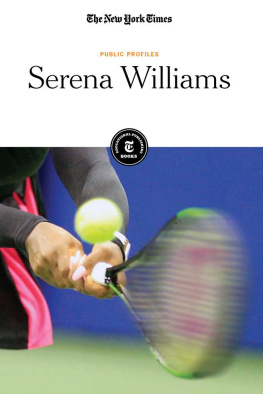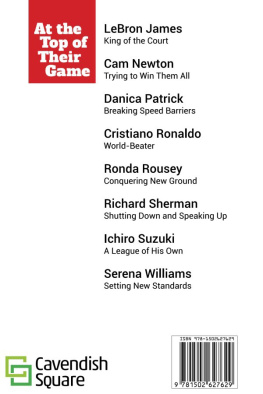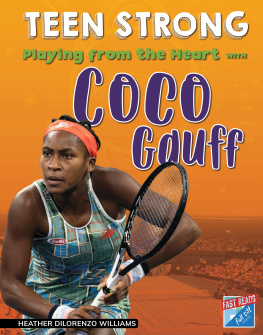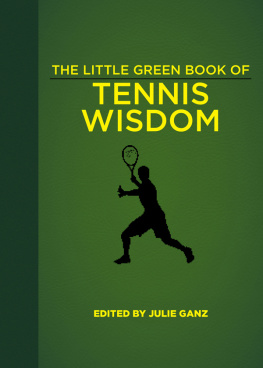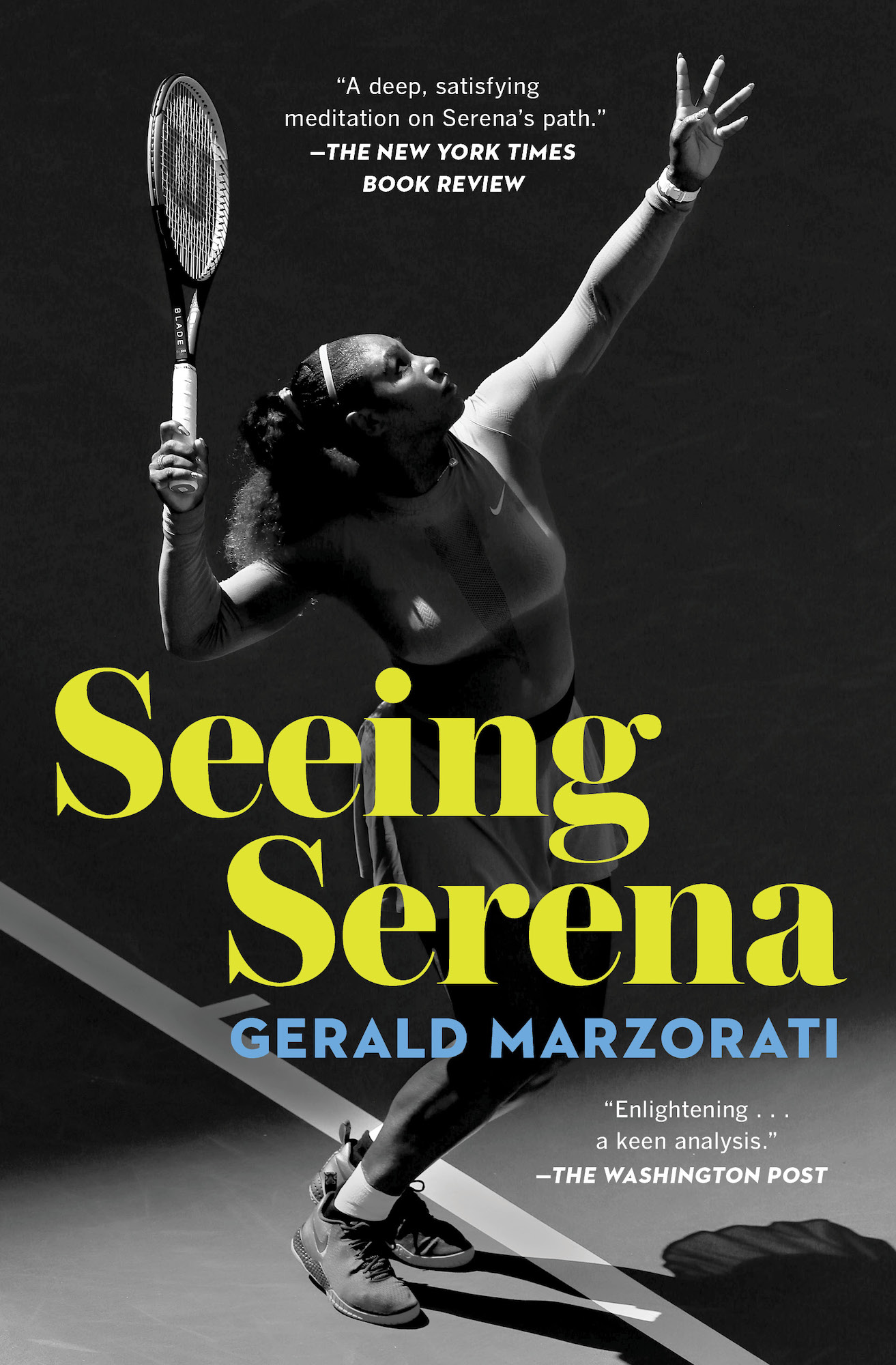Contents
Guide
Seeing Serena
Gerald Marzorati
Praise for Seeing Serena
Thoughtful... Theres plenty of insight and detail in this book to please tennis nerds, but this is also a travelogue covering Marzoratis year following Williams from Melbourne to Paris to London to New York. He gives us some of the flavor from each stop such that you get more than just tennis, you get the feel of having been on this dream trip following Serena around the globe.... Marzorati has written a deep, satisfying meditation on Serenas path.
Tour, The New York Times Book Review
Enlightening... Marzoratis wide-ranging approach blends well with his keen analysis as he covers everything from Williamss aggressive play to her locker-room evolution, from isolation (in no small part because of racism and because of how the Williams sis-ters dominance intimidated other players) to finding close friends to becoming a revered elder. He even effectively draws connections between Williams and both Rihanna and painter Faith Ringgold, writing about topics like the struggle to reshape beauty norms and create a new identity for successful modern Black women.
The Washington Post
What would a year spent watching every Serena Williams ten-nis match yield? A portrait both on and off the court of one of the greatest athletes of all time. New Yorker tennis writer Gerald Marzoratis Seeing Serena captures Williamss return to tennis fol-lowing the birth of her daughter and her influence and presence as a cultural icon.
Parade, Books We Love column
With just enough backstory and supportive interviews, [Mar-zorati] effectively incorporates relevant history of Williamss pre-vious Grand Slam tournaments while also examining her roles in challenging cultural norms and fighting for gender equality. Mar-zorati has an easy-to-read style and reveals the complexity of Wil-liamss life, not just as an athlete, but also as a celebrity."
Booklist
Well written.... This is a solidly reported book.
Publishers Weekly
The level of this analysis is quite impressive.
Library Journal
Readers who know more about Williams than her tennis career will learn about the games intricacies while those already familiar with the game will benefit from subtler details.
Kirkus Reviews
Also by Gerald Marzorati
A Painter of Darkness
Late to the Ball

Scribner
An Imprint of Simon & Schuster, Inc.
1230 Avenue of the Americas
New York, NY 10020
www.SimonandSchuster.com
Copyright 2020 by Gerald Marzorati
Portions of this book were previously published, in different form, on NewYorker.com and in the journal Racquet.
All rights reserved, including the right to reproduce this book or portions thereof in any form whatsoever. For information, address Scribner Subsidiary Rights Department, 1230 Avenue of the Americas, New York, NY 10020.
First Scribner hardcover edition August 2020
SCRIBNER and design are registered trademarks of The Gale Group, Inc., used under license by Simon & Schuster, Inc., the publisher of this work.
For information about special discounts for bulk purchases, please contact Simon & Schuster Special Sales at 1-866-506-1949 or .
The Simon & Schuster Speakers Bureau can bring authors to your live event. For more information or to book an event, contact the Simon & Schuster Speakers Bureau at 1-866-248-3049 or visit our website at www.simonspeakers.com.
Interior design by Erich Hobbing
Jacket design by Math Monahan
Jacket photograph by Elsa / Staff / Getty Images Sport
Library of Congress Cataloging-in-Publication Data has been applied for.
ISBN 978-1-9821-2788-6
ISBN 978-1-9821-2790-9 (ebook)
For Roger Angell
There are years that ask questions, and years that answer.
Zora Neale Hurston, Their Eyes Were Watching God
Culture does not make people. People make culture.
Chimamanda Ngozi Adichie, We Should All Be Feminists
INTRODUCTION
It was the last weekend of September 2018 when Saturday Night Live kicked off its forty-fourth season. Three weeks earlier, Serena Williams had played Naomi Osaka in the US Open womens final, a match that was among the most bizarre and controversial in the history of professional tennis, a match made memorable by Williamss clashing loudly and unceasingly with the chair umpire, Carlos Ramos. Three weeks is a long time ago in the digital-age news cycle, but there, on SNL that Saturday night in early fall, was the comedian Leslie Jones, crashing the Weekend Update sketch in a one-shoulder silhouette tennis dress with a tulle skirtlike the dress Williams wore at the US Openand waving a Wilson Blade 104, the racquet Williams uses. It was meta-comedy: Jones burst into the skit, insisting, in a dead-on Serena impersonation, that she was owed an apology, hilariously mashing up Serenas already notorious tirade aimed at the chair umpire in the womens finalWilliams believed she was owed an apology for being charged with a violation she felt implied that she was cheatingwith her, Joness, accusatory rant that a planned Serena skit had been cut from the show. One of the Weekend Update anchors tried to reason with Jones, as she yelled and swung phantom forehands: The Williams-Osaka match was old news. But what made the bit work was that the match wasnt old news, that it was still being brought up, mulled over, parsed, argued about. I couldnt remember the last time a sports controversy, or any sort of pop-culture controversy, had remained a part of the general conversation for so long. What was it? Or better, what was it about Serena?
Watching Leslie Jones as Serena Williams for a minute and a half: thats where the idea for this book began. What was it about Serena? The it was complex, singularly so, which made the idea alluring. There was her indisputable greatness as a tennis player, which, as someone who wrote frequently about tennis, I was familiar with. But there was her broader presence in the culture, too: as a woman, as a black woman, as a striving woman from a striving family, as a powerful woman, as a sometimes angry woman, as a wealthy woman, as a fashion-conscious woman, as a woman who was a social-media influencer, as a working woman with a baby. Williams struck me, and I sensed struck others, too, as someone ever presenta global celebritybut not quite apprehended. And the more you thought about her, the more myriad-minded you grew. That was alluring to me, too.
This is not an authorized book. I got no special access to Williams or those closest to her. That would have entailed making it her book, ultimately, which was not what interested me. She has told her own story in many forms and many forums and will no doubt continue to do so. I wanted, simply and not so simply, to see her in all the ways I could: watch her, describe her, listen to her, read about her, follow her (in the new conditions of seeing created by Instagram, etc.), interpret her, situate her. My tools were sports writing, biography, reportage, and cultural criticism. The narrative armature of the book is Williamss return to tennis after giving birth to her daughter and her quest to win another Grand Slam or two, to tie and maybe break a long-standing record and win a major as a mom. I spent a year on the womens tour, watching live nearly every match Williams played, attending her press conferences, talking to players, coaches, journalists, and others. The form I chose for the book is prismatic, collage-like. The point was to see Serena Williams from as many angles as I could. It is Serena Williamss complexity, even beyond her greatness on court, that has made her the most consequential athlete of her time, and it is my hope that this book, in its way of telling, evokes and somehow deepens that complexity.

